South Korean Night Black Hole Spatial Disorientation Helicopter Fatal Accident (National 119 Rescue Airbus Helicopters H225 HL9619)
On 31 October 2019 emergency service Airbus H225 HL9619 of National 119 Rescue crashed into the sea just 14 seconds after take off from the island of Dokdo during a patient transfer medevac flight. All 7 occupants died in the accident.

Submerged Wreckage of National 119 Rescue Airbus Helicopters H225 HL9619 (Credit: ARAIB)
The South Korean Aviation and Railway Accident Investigation Board (ARAIB) issued their safety investigation report (in Korean) on 6 November 2023. This accident summary is based on a translation of this report. Note: ambiguities after translation did made interpretation challenging but we are confident the content here represents the final report accurately.
The Accident Flight
National 119 Rescue is fire-fighting, air ambulance, mountain & maritime Search and Rescue (SAR) organisation, ultimately a part of the Korean National Fire Agency.
The helicopter was tasked to fly east from Daegu on the mainland to Dokdo Heliport on an rocky offshore island, to retrieve a fisherman who was on the island after had suffering a severed finger on a fishing vessel. On board were 5 crew (two pilots, a flight engineer / hoist operator, a winchman and paramedic). The captain had 3,827 flying hours total experience, 444 on type. The first officer had 2,666 flying hours total experience, 307 on type.
The flight crew had no prior experience landing at Dokdo and investigators state that during their flight planning the crew were unable to obtain “information about the terrain of the landing area or the heliport to the extent the crew desired”.
The helicopter departed Daegu at 22:33 and refuelled successfully at Ulleungdo island en route. The captain complained of being tired during the flight. The captain was working an extended shift due to a business trip involving another pilot.
The aircraft was fitted with a Night Vision Imaging System (NVIS). Investigators note that the…
National Fire Agency does not have a clear basis for the operation of night vision equipment., Pilots selectively use night vision equipment depending on individual preference.
Evidence from an Appareo Vision 1000 recording system confirmed the pilots were using their Night Vision Goggles (NVGs) when the aircraft departed, though the Vision 1000 video recording ceased during the flight. Cockpit Voice Recorder (CVR) evidence was that the NVG continued to be used intermittently as necessary during the flight.
CVR data suggested that Automatic Flight Control System (AFCS) selections were not being verbalised and “there were cases where the first officer did not realize the captain’s intentions”.

Route to Dokdo of National 119 Rescue H225 HL9619 (Credit: ARAIB)
The 25 m square Dokdo heliport, at an elevation of 177 ft, was operated by the Gyeongbuk Provincial Police Agency, but they lacked specific heliport procedures and personnel with relevant competencies.
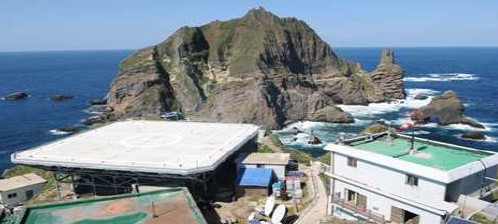
Dokdo Heliport (Credit: ARAIB)
This was the first night landing at the site in 3 years. Two of the four perimeter flood lights were unserviceable, though the green perimeter lights were serviceable.
Visibility was good with no clouds or sea fog but little illumination form the waxing crescent moon. There was a crosswind at Dokdo, that was likely to have induced turbulence and no illuminated windsock.
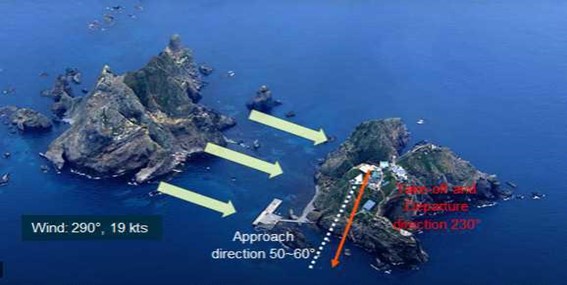
Crosswind at Dokdo for National 119 Rescue H225 HL9619 (Credit: ARAIB)
The helicopter landed at Dokdo at 23:24 after one missed approach (with a torque exceedance). The missed approach followed a miscommunication between aircraft and ground resulted in all lights at the site being briefly extinguished. During the second landing attempt a person at the site tried to help the flight crew by waving a spotlight in the direction of the approaching helicopter, which investigators postulate “may have acted as a temporary visual disturbance”. They also suggest that communication by a rear crew member may have been distracting.
A TV crew caught the arrival (including the spotlight) and part of the departure:
While the patient and an accompanying colleague boarded, the flight crew discussed the difficulties during the approaches and the go around. However, there was no pre-take off briefing.
Investigators believe the Pilot Flying, the aircraft commander, intended to select the ‘GA’, AFCS Go Around mode during take off, did not but mistakenly believed it was engaged.
Investigators believe the NVIS was not utilised during the take off from Dokdo. They note that while at the elevated helipad the aircraft had been exposed to bright lights.
As the helicopter transitioned forward they entered darkness, what is known as a ‘black hole’. Such conditions typically occur over water or over dark, featureless terrain where the only visual stimuli are lights located on and/or near the airport or landing zone. We discussed a similar case onshore in 2016: HEMS Black Hole Accident: “Organisational, Regulatory and Oversight Deficiencies”
Investigators believe the Pilot Flying most likely suffered a somatogravic illusion that gave the false impression of pitching up and induced an unnecessary nose down adjustment.
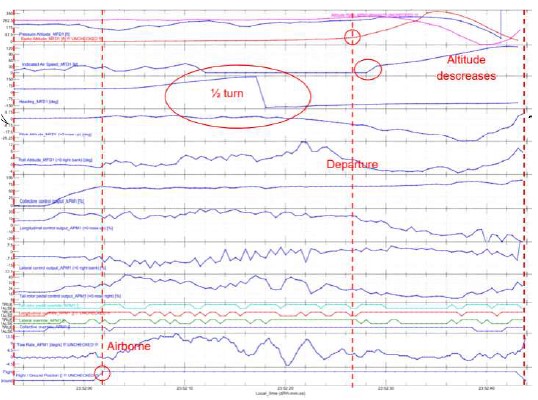
FDR Data Last Two Sectors – National 119 Rescue H225 HL9619 (Credit: ARAIB)
A short SKYclip on somatogravic illusions is available here:
As such an illusion was a foreseeable scenario investigators suggest that the intervention of the Pilot Monitoring should have been part of the (absent) pre-flight briefing.
There were warnings (three power limit Gongs, ‘Don’t Sink’ and ‘Warning Terrain’) in fast succession as the helicopter approached the sea surface. The peak rate of descent was 3,425 ft/min.
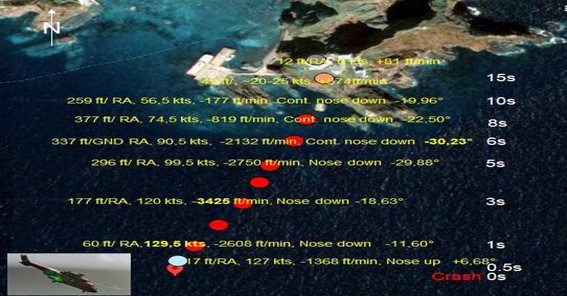
Take Off Flight Profile of National 119 Rescue H225 HL9619 (Credit: ARAIB)
The helicopter impacted the sea just 486 m from the heliport.
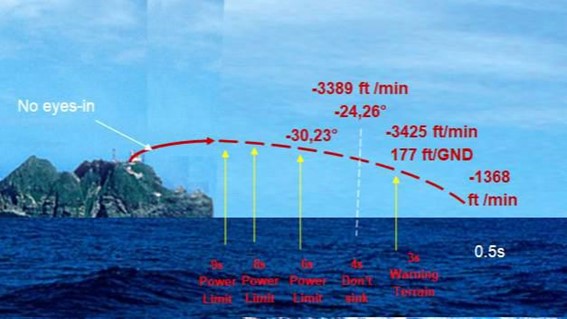
TAWS Warnings During Take Off of National 119 Rescue H225 HL9619 (Credit: ARAIB)
The emergency flotation system and front part of the fuselage were completely destroyed. Investigators estimate the impact was a non-survivable 54.54G deceleration.
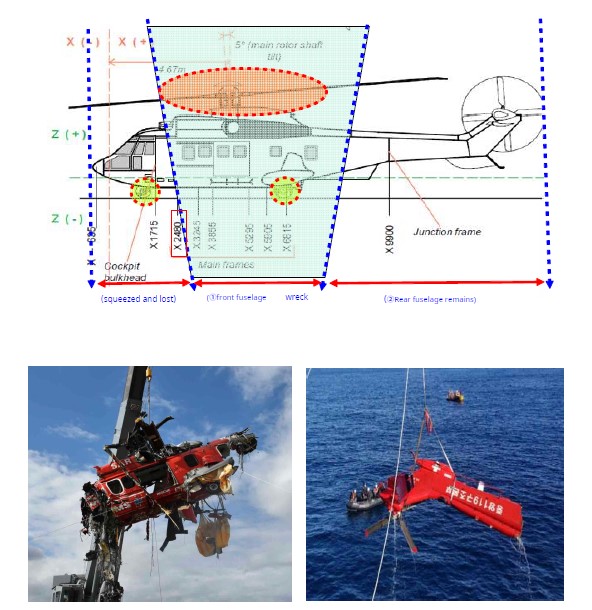
Wreckage of National 119 Rescue Airbus Helicopters H225 HL9619 (Credit: ARAIB)
ARAIB Cause
HL9619 crashed due to spatial disorientation of the pilot, who did not perceive the change in aircraft attitude after passing through the steep slope of Dokdo, transitioning from a bright area to a very dark sea immediately after takeoff from the Dokdo Heliport.
ARAIB Contributing Factors
- The crew did not receive detailed pre-flight briefings, including mission briefings and task allocation at Dokdo Heliport, from the Central 119 Rescue Headquarters before the flight.
- During takeoff from Dokdo, the pilot mistakenly believed that the autopilot was in G/A mode and, during the process of accelerating the aircraft, misinterpreted the strong attitude of the aircraft as a climb.
- Mistaking the aircraft’s strong attitude for a climb, the pilot continuously pushed the control stick (Cyclic), rendering the autopilot ineffective (Override), and causing an increase in speed and descent rate.
- The pilot experienced visual illusions caused by various lights during the approach to Dokdo Heliport, which also influenced the takeoff phase.
ARAIB Safety Recommendations
ARAIB raised 7 safety recommendations to the National Fire Agency, that related to:
- Preparing and implementing a fatigue management plan
- More flight simulator training
- More night take-off and landing training
- SMS enhancement
- Establishing NVIS procedures and training in confined areas and elevated helipads
- Enhanced aviation management
- More CRM and automation training
The National Police Agency were recommended to:
- Establish procedures for the operation of Dokdo heliport
Airbus were recommended to:
- Issue a Safety Information Notice on AFCS use (SIN 3558-S-22 was issued In December 2020):
Safety Resources
The European Safety Promotion Network Rotorcraft (ESPN-R) has a helicopter safety discussion group on LinkedIn. You may also find these Aerossurance articles of interest:
- Taiwan NASC UH-60M Night Medevac Helicopter Take Off Accident
- Technology Friend or Foe – Automation in Offshore Helicopter Operations
- The ‘Automation Problem’ – A Discussion
- HEMS S-76C Night Approach LOC-I Incident a near accident in Canada
- Loss of Control, Twice, by Offshore Helicopter off Nova Scotia
- Blinded by Light, Spanish Customs AS365 Crashed During Night-time Hot Pursuit
- Deadly Combination of Misloading and a Somatogravic Illusion: Alaskan Otter
- Life Flight 6 – US HEMS Post Accident Review
- Night Offshore Winching CFIT a German HEMS unit attempts night offshore winching
- US Police Helicopter Night CFIT: Is Your Journey Really Necessary?
- Fatal Night-time UK AW139 Accident Highlights Business Aviation Safety Lessons
- Low Viz Helicopter Accident, Alaska
- NTSB Investigation into AW139 Bahamas Night Take Off Accident
- ‘Procedural Drift’: Lynx CFIT in Afghanistan
- Deadly Combination of Misloading and a Somatogravic Illusion: Alaskan Otter
- Dim, Negative Transfer Double Flameout
- Air Ambulance Helicopter Struck Ground During Go-Around after NVIS Inadvertent IMC Entry
- Italian HEMS AW139 Inadvertent IMC Accident
- HEMS A109S Night Loss of Control Inflight
- BK117B2 Air Ambulance Flameout: Fuel Transfer Pumps OFF, Caution Lights Invisible in NVG Modified Cockpit
- HEMS AW109S Collided With Radio Mast During Night Flight
- SAR Helicopter Loss of Control at Night: ATSB Report
- A HEMS Helicopter Had a Lucky Escape During a NVIS Approach to its Home Base
- NVIS Autorotation Training Hard Landing: Changed Albedo
- EC135 Air Ambulance CFIT when Pilot Distracted Correcting Tech Log Error
- North Sea Helicopter Struck Sea After Loss of Control on Approach During Night Shuttling (S-76A G-BHYB 1983)
- UPDATE 9 Dec 2023: Fire-fighting Bell 204B Underwater Escape
- UPDATE 17 February 2024: Night Offshore Take-Off Loss of Control Incident
- UPDATE 18 February 2024: Night Offshore Helicopter Approach Water Impact
- UPDATE 13 July 2024: Fatal USCG SAR Training Flight: Inadvertent IMC
Another short SKYclip on somatogravic illusions is available here: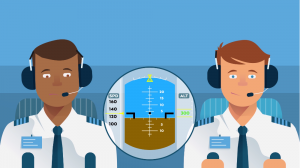

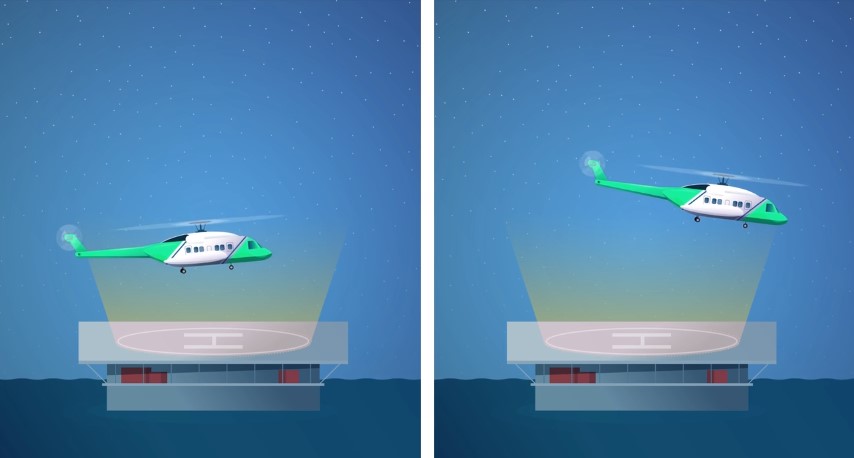

Recent Comments